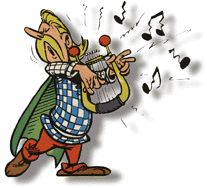 |
Musical Instruments of Antiquity as Illustrated in
|  |
Part 6: Stringed Instruments (Lyre, Harp, Lute, Rebec)
The Lyre
| Lyre - "david's harp" |
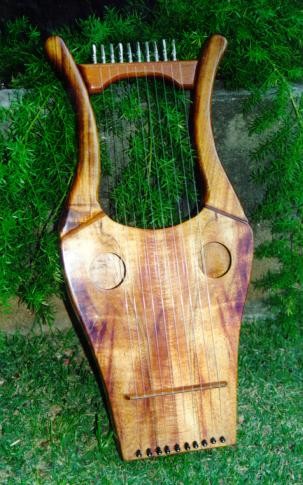

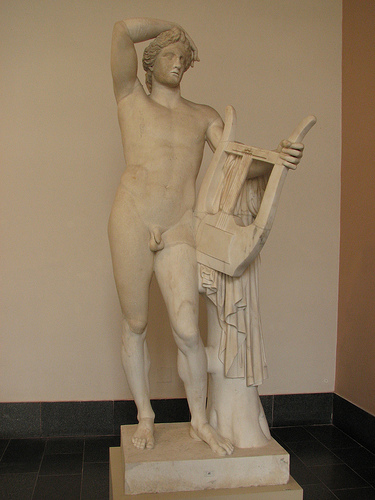
|
| Lyre - Greek and Roman |

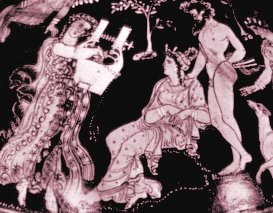

|
| In the world of Asterix, the lyre was used by the Romans to accompany meals. In Asterix and the Roman Agent, a musical ensemble consisting of a wood lyre, aulos and tambor provide music for a meal in Julius Caesar's villa. Not only were the elite politicians entertained a mealtime my music. Meals to the accompaniment of lyres was also the priviledge of Roman olympian Gluteus Maximus in Asterix and the Olympic Games Notice the two diffent lyre constructions: wood and animal horn. |
 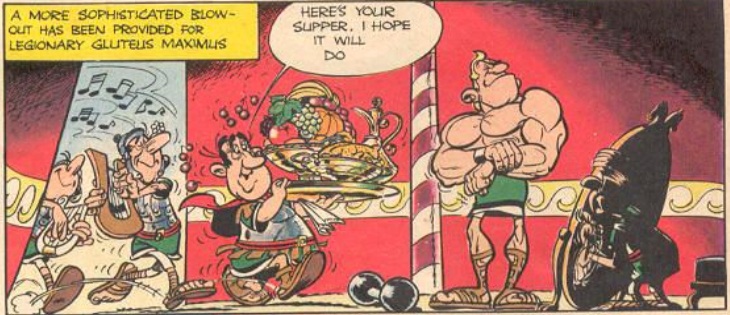
|
| This class distinction apparently became an issue once collective bargaining and unions began to assert themselves as tools for empowerment by the common man. In Asterix and the Mansions of the Gods the legionaries demand that the more pleasant musical sounds of the lyre be used to announce mealtimes instead of buccina. Management is forced to conceed the issue in order to keep the troops at bay. |

|
|
The lyre is, by far, Cacofonix the Bard's favorite musical instrument. He is rarely seen without it, and is constantly playing it and trying to sing - much to the consternation of anyone else who happens to be nearby. Cacofonix's lyre is of a different style from the Roman lyre. Instead of a wood frame with a resonator and soundboard, the frame for this lyre appears to be made from two bull horns, with some metalwork to support the strings and embellishment at the horn tips.
|


|
|
It may be that a lyre made from animal horns is easier to repair or rebuild than one made from wood. One of the running gags throughout the Asterix books is the glee with which Fulliautomatix the blacksmith delights in bashing Cocofonix and smashing his lyre anytime he even looks like he might begin to sing, as illustrated in these scenes from Asterix and the Goths, Asterix and Cleopatra, and Asterix and the Great Crossing.
Occasionally even the Romans join in and attempt to prevent Cacofonix from singing, as in Asterix the Gladiator. Usually, however, the bashing is reserved for Cacofonix himself. . . . . . |
  

|
| . . . though once in a while Fulliautomatix takes pleasure from smashing the lyre itself, as shown in this scene from Asterix and Caesar's Gift. |
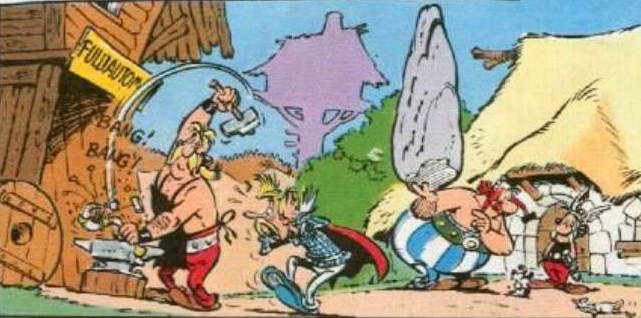
|
| Perhaps part of the reason Cacofonix's audience reacted so negatively to his music was that the Gaulish Bardic style of playing the lyre appears to be different from what the Greeks and Romans used. Instead of strumming the lyre strings with a plectrum, Cacofonix plucks the strings of his lyre. As a result, the sounds, as faithfully rendered by Uderzo in these scenes from Asterix and the Big Fight and Asterix in Spain and Asterix and the Normans, are not pleasant musical tones, Instead, Caconofix produces more abrasive CLONG, CLING, TOING, CLONG, TDZOiiiiNG, DZOOOONG, and TZiiiiiiiiNG. |

 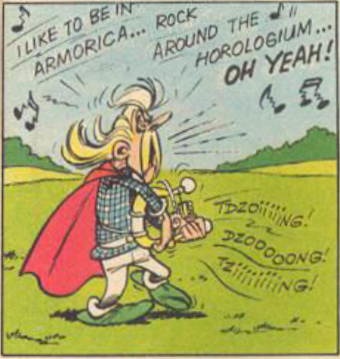
|
| In Asterix and the Normans, a young Lutetian introduces Cacfononix to an alternative strumming technique, which he uses to some effect when attempting to teach the Norman invaders the meaning of fear. |

|
|
In Asterix the Gladiator, Goscinny and Uderzo reveal a lesser known use of the lyre as a musical instrument. As was the case with other ancient musical instruments, like the carnyx and alphorn, the lyre proves to be a useful and powerful weapon to drive off pesky Roman legionaries.
|

|
The Egyptian Harp
| The harp is a plucked stringed instrument of varying size, played while held in the lap or supported on the floor. The strings are perpendicular to the soundboard (most strings instruments like the piano, guitar, or violin have strings parallel to the soundboard). The soundboard of the harp usually contains a resonator. Ancient Egyptian harps varied considerably in size (containing anywhere from 4 to 22 strings) with smaller harps usually carried on the shoulder, and the larger, curved harps (sometimes called "bowed" harps) supported on the floor while the player either stood or kneeled to play. |
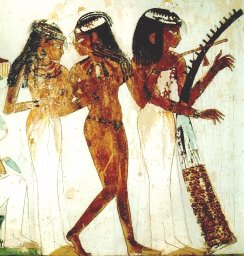

|
| Judging from ancient Egyptian paintings, the harp was a prominent instrument at the royal court, and at religious ceremonies. Many tomb paintings show musicians playing various size and style harps. Harps are even depicted as being played by deities (perhaps the origin of the imagery of angels playing harps in heaven?) |
 
|
| Uzerozo appears to have done his research on ancient Egyptian musical instruments. In Asterix and Cleopatra Asterix, Obelix, Dogmatix, and Getafix visit Egypt to help an architect friend of Getafix's build a palace so Cleopatra can win a bet with Julius Caesar. When they are introduced to Queen Cleopatra (who, by all accounts, was believed to have a very beautiful nose) the queen is flanked by musicians, one of whom is playing a realistic looking bow harp. |

|
Rebec (viol)
| The rebec (rebac) is a stringed instrument that rose to popularity in the 14th and 15th centuries. Typically is has three strings which could be tuned by adjusting the tension, and was played with a bow. The rebec later evolved into the violin and its relatives. |
 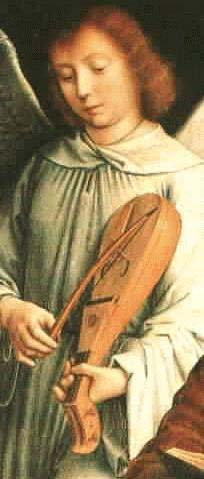
|
| According to Goscinny and Uderzo, this instrument was already a mainstay of the Gaulish Bard in 50 B.C. In fact, when we are first introduced to Asterix and his fellow villagers in the very first story, Asterix the Gaul, the two musical instruments the village bard is seen playing are a bagpipe and a rebec. The bowed stringed instrument was not restricted to Asterix's village, however. When Asterix and Obelix travel to Lutetia in Asterix and the Golden Sickle to find a replacement sickle for Getafix the druid, they stop in an inn where music is provided by a band including a rebec player along with a lyre and what looks to be an early form of serpent. |
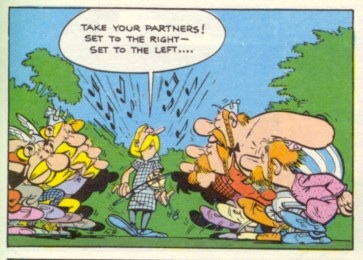 
|
Greco-Roman Lute
| The ancient lute appears frequently in Egyptian and Greco-Roman frescos, murals, and sculptures dating from as early as 500 BC. It would seem that the instrument first emerged from Mespotamia, and the Ancient Sumerian word pantur is believed to be the earliest term for the plucked lute. Most lutes had three tunable strings stretched over a long neck and attached to a hollowed-out wooden body resonator, sometimes covered with animal skin. Some depictions show sound holes in body of the resonator. The instrument appears to be played in much the same way as the modern guitar - strummed with one hand (right hand in most renderings) with the other hand fingering the strings on the neck. |
 
|
| Unfortunately, while images of lutes and similar plucked stringed instruments abound in ancient Egyptian, Greek and Roman frescoes and sculptures, there are almost no specific or technical descriptions of the lute as a musical instrument in period writings discussing ancient music. There are many references in the literature to lyre, but few refereces to the plucked lute. This has led some scholars to believe that the lute was only a minor musical instrument of little importance in Greco-Roman culture. However, the prominence of the instrment in art would suggest otherwise. |
|
| The plucked lute does not make a prominent appearance in Asterix, though it is shown once or twice. In Asterix and the Goths the village bard, Cacofonix, is shown tuning a long-necked chordophone. In Asterix in Spain a lute (looking more like an early banjo) is among the various instruments in the Bard's hut. |
 
|
| Of course, the immense later popularity of music played on plucked stringed instruments with long necked fingerboards was greatly enhanced by the extremely popular British Bardic group that Asterix encounters in Asterix in Britain. |

|
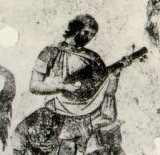
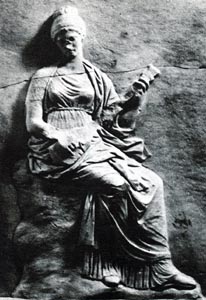
 Music in Asterix TOC
Music in Asterix TOC